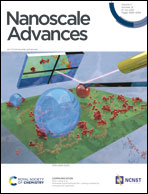MoS2 nanoparticle/activated carbon composite as a dual-band material for absorbing microwaves†
Abstract
In the search for novel high-performance microwave (MW) absorbers, MoS2 has shown promise as a MW-absorbing material, but its poor impedance matching limits its applications. Herein, a facile hydrothermal method was used to produce a composite consisting of activated carbon (AC) derived from waste biomass and in situ-grown MoS2 nanoparticles. Its microwave absorption properties were examined in the 2–18 GHz frequency range, and FESEM and HRTEM images confirmed the formation of MoS2 nanoparticles on the AC. The maximum reflection loss (RLmax) for the MoS2/AC composite was −31.8 dB (@16.72 GHz) at 20 wt% filler loading. At 50 wt% filler loading, the MoS2/AC (MAC50) composite exhibited unique dual-band absorption characteristics in the C and Ku bands. An effective absorption bandwidth (RL < −10 dB) of 10.4 GHz (3–5.2 GHz, 9.8–18 GHz) was achieved at various thicknesses that covered the entire Ku band. Therefore, a sole dielectric absorber can easily be tuned to absorb MWs at multiple frequency ranges. The large surface area and conduction losses of AC combined with the superior dielectric loss properties of MoS2 resulted in improved impedance matching and attenuation ability of the MoS2/AC composite. Thus, MoS2/AC is a promising low-cost dielectric absorber for MW absorption applications.



 Please wait while we load your content...
Please wait while we load your content...